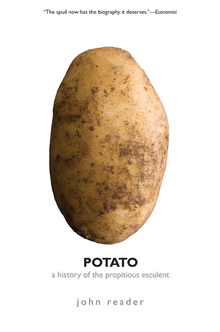Potato
WARNING
You are viewing an older version of the Yalebooks website. Please visit out new website with more updated information and a better user experience: https://www.yalebooks.com
A History of the Propitious Esculent
John Reader
The long journey of the potato, from Incan gardens in the Andes thousands of years ago to a NASA manned rocket destined for Mars in the twenty-first century
The potato—humble, lumpy, bland, familiar—is a decidedly unglamorous staple of the dinner table. Or is it? John Reader’s narrative on the role of the potato in world history suggests we may be underestimating this remarkable tuber. From domestication in Peru 8,000 years ago to its status today as the world’s fourth largest food crop, the potato has played a starring—or at least supporting—role in many chapters of human history. In this witty and engaging book, Reader opens our eyes to the power of the potato.
Whether embraced as the solution to hunger or wielded as a weapon of exploitation, blamed for famine and death or recognized for spurring progress, the potato has often changed the course of human events. Reader focuses on sixteenth-century South America, where the indigenous potato enabled Spanish conquerors to feed thousands of conscripted native people; eighteenth-century Europe, where the nutrition-packed potato brought about a population explosion; and today’s global world, where the potato is an essential food source but also the world’s most chemically-dependent crop. Where potatoes have been adopted as a staple food, social change has always followed. It may be “just” a humble vegetable, John Reader shows, yet the history of the potato has been anything but dull.
Do You Know Your Spuds?
A multiple-choice potato quiz
(answers below)
1: French fries were first introduced to the United States by
a. Benjamin Franklin
b. John Adams
c. Washington Carver
d. Thomas Jefferson
2: The ’s largest potato producer today is
a. Ireland
b. China
c. Australia
d. Peru
3: From what part of the plant does the potato come?
a. The root
b. The flower
c. The leaf bud
d. The stem
4: Other crop plants closely related to potatoes include
a. Tomato, chili peppers, and petunias
b. Corn, beans, and millet
c. Kava, marijuana, and peyote
d. Rice, sugar cane, and maize
5: Potato blight is
a. A kind of mold
b. A wart
c. A parasitic insect
d. A parasitic plant
6: How many people died in Ireland as a result of the potato blight and subsequent famine?
a. 100,000
b. 4 million
c. 1 million
d. 500,000
7: Scientists are conducting experiments with potatoes in order to determine their usefulness
a. as a food source for astronauts on the next mission to Mars
b. as a healing agent in organic medications
c. as inexpensive insulation in buildings
d. as an insecticide
8: A poisonous plant that is a close relative of the potato is
a. Deadly nightshade
b. Poinsettia
c. Daffodil
d. Poison ivy
9: The potato was first introduced to Europe in
a. About 1780
b. About 1588
c. About 1650
d. About 1492
10: The original name of the potato in Quechua, the language of the Inca, is
a. Tapas
b. Papa
c. Pate
d. Tater
(Spud Quiz Answers: 1:d. 2:b, 3:d, 4:a, 5:a, 6:c, 7:a, 8:a, 9:b, 10:b)
"[This] accessible account embraces the latest scholarship and addresses the failings of previous works on the subject. Indeed the book, like the tuber it describes, fills a void: the spud now has the biography it deserves."—Economist
"As a staple of the global diet, the potato is worth this digestible book . . ."—Iain Finlayson, Times
". . . rarely has this kind of thing been done so well."—Giles Foden, Conde Nast Traveller
Publication Date: March 29, 2011
17 b/w illus.








